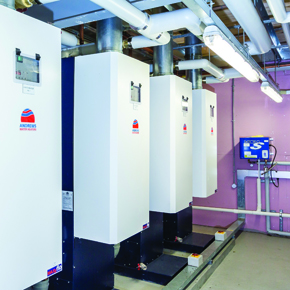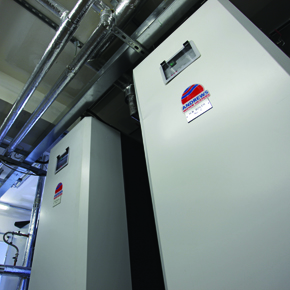
Warming up to BIM
This year, public sector centrally procured construction projects will be required to be delivered using Building Information Modelling (BIM) Level 2. Chris Meir, sales director at Andrews Water Heaters, explains what this means for the HVAC sector and what improvements it will bring…
As we kick off the start of a new tax year, public sector building is set to undergo a period of intense change, as new requirements to use BIM Level 2 for all centrally procured projects promises to improve ways of working at a time of growth for the construction sector.

“It is cause for concern, however, that industry research released towards the end of last year has highlighted that a large contingent of contractors are not yet ready for BIM Level 2” – Chris Meir
While hinting at further public sector cuts in the future, last month the Chancellor also outlined plans to invest further in education and children’s healthcare, which has the potential to bolster the burgeoning upturn that construction is enjoying at the moment. For example, plans to enable schools to stay open longer in order to offer more extracurricular activities highlighted a new focus on sports, which may, in turn, fuel an ongoing trend for greater investment in sports facilities within educational establishments and leisure centres.
Meanwhile, funding streams announced in the Budget will see Government invest in children’s hospitals in Manchester, Sheffield, Birmingham and Southampton. Other measures included some detail on plans to deliver a total of 400,000 affordable housing starts by 2020-21, including releasing capital spending early.
From leisure centres and schools to healthcare and supported housing, direct gas-fired water storage heaters can offer an energy-efficient supply of plant room hot water when paired with either separate plant heating or electric heating.
In the midst of this growth, the new BIM Level 2 requirements mark an important turning point for the construction industry. Also, looking to the future with the Government’s Digital Built Britain report as our guide, it is clear that Level 2 BIM is, in part, a stepping stone to the implementation of Level 3, underlining the importance of professionals across the industry to make BIM Level 2 part of their day-to-day lives.
This is even more important when we consider that the changes are sure to impact the full length of the construction chain, with facilities managers no exception. For them, BIM offers a huge opportunity to deliver improved efficiencies. As it requires design and asset information, documentation and data to be electronic and finally delivered as an asset information model, in practice it will mean that more complete information will be available from handover, enabling a more collaborative work flow and smoothing the transition from design and build to operation and management.
When fully embedded, BIM as a working methodology could provide tools to help in closing the building performance gap, better delivering the energy efficiencies predicted at the design stage in the actual operation of the building. At the same time, it will provide a readily accessible source of information for the teams involved in operating, maintaining and adapting completed facilities.
Let’s take the creation of an asset register as an example. Traditionally, it is a time consuming job, which might involve contacting the various contractors and manufacturers for copies of the relevant manuals and then formatting that information as required. However, BIM simplifies this process.
It is cause for concern however that industry research released towards the end of last year has highlighted that a large contingent of contractors are not yet ready for BIM Level 2.
Some contractors may be under the impression that they will be able to buy some time after the April deadline and between tenders to finish their preparations. However, contractors working in the public sector should remember that while the number of centrally procured projects will continue to rise, being fully prepared and able to implement BIM Level 2 will soon become an essential, competitive edge to compiling a relevant portfolio and winning more work in the future.
In the rush to get up to speed, it is important for firms to take a planned approach if they are to protect themselves from costly mistakes and falling foul of the deadline.
For instance, it needs to be remembered that BIM is both a new technology and a more collaborative way of working where the deliverables are more defined. To adapt, contractors must both invest in training while managing cultural change within their organisations – something that smaller consultants may struggle to accommodate without careful planning.
With a number of building firms not yet ready, the onus is also on manufacturers to engage with and support clients in making changes that will benefit their businesses in the long term.
Ultimately, BIM Level 2 is certain to become a valuable tool in assisting efficient practice in building management while positioning the UK as a global construction leader in the international market.
Find out more in the April 2016 issue of PSB Magazine
Latest news

19th April 2024
ASSA ABLOY: Access solutions can impact sustainability performance across the full life-cycle of a building
Embedding sustainability within any organisation requires a broad, strategic perspective. Scrutiny should include the physical infrastructure itself: According to the IEA, buildings consume around 30% of global energy*. ASSA ABLOY has more…
Posted in Access Control & Door Entry Systems, Architectural Ironmongery, Articles, Building Industry News, Building Products & Structures, Building Regulations & Accreditations, Building Services, Case Studies, Doors, Facility Management & Building Services, Information Technology, Research & Materials Testing, Retrofit & Renovation, Security and Fire Protection, Sustainability & Energy Efficiency, Video of the Week
19th April 2024
British weather doesn't dampen spirit for new HMG Garden Paint
Despite one of the wettest starts to the year on record, customers are starting to plan for brighter days with HydroPro Garden Paint from HMG Paints.
Posted in Articles, Building Industry News, Building Products & Structures, Garden, Innovations & New Products, Paints, Paints, Coatings & Finishes, Restoration & Refurbishment, Retrofit & Renovation, Site Preparation, Sustainability & Energy Efficiency, Waste Management & Recycling
18th April 2024
Abloy UK showcases new digital portfolio at The Security Event 2024
Abloy UK is set to unveil its latest line-up of access control systems at The Security Event 2024, welcoming guests to explore its cutting-edge electromechanical and digital solutions on stand 5/F50.
Posted in Access Control & Door Entry Systems, Architectural Ironmongery, Articles, Building Industry Events, Building Industry News, Building Products & Structures, Building Services, Doors, Exhibitions and Conferences, Facility Management & Building Services, Health & Safety, Information Technology, Retrofit & Renovation, Security and Fire Protection
18th April 2024
Strand is a Failsafe Choice for Emergency Exit and Panic Hardware
In times of emergency, you’re in safe hands with Strand Hardware. Although there are many considerations for building specification, few decisions can be as critical as selecting the right emergency exit/panic hardware.
Posted in Access Control & Door Entry Systems, Architectural Ironmongery, Articles, Building Industry News, Building Products & Structures, Building Services, Doors, Facility Management & Building Services, Health & Safety, Restoration & Refurbishment, Retrofit & Renovation, Security and Fire Protection
 Sign up:
Sign up: